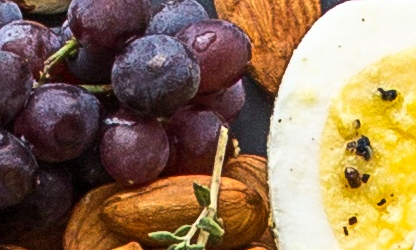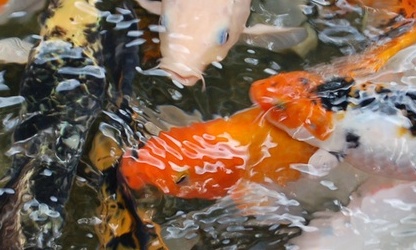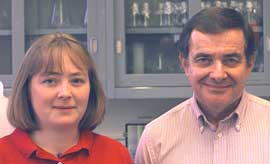

FoodTech Source
Britta Leverentz and William Conway: Focusing on Phage-Enhanced food safety USDA Agricultural Research Service plant pathologists Britta Leverentz and William Conway, working out of the ARS Produce Quality and Safety Laboratory in Beltsville, Maryland, recently announced the successful conclusion of the first phase of a study which sought to control foodborne pathogens on fresh-cut fruits and vegetables through the use of bacteriophages " viruses that infect and kill bacteria. This first-of-its-kind study was part of a cooperative agreement with Intralytix, Inc. " a Baltimore, Maryland-based Corporation which provided known phages for Salmonella strains as a model. FoodTechSource.com recently spoke with Leverentz and Conway to better understand the impact of their work.
FoodTechSource.com: Can you provide an overview of your research?
Britta Leverentz, Ph.D.: We investigate food safety issues " in this case the elimination, using biocontrols, of foodborne pathogens present on the surface of fresh-cut fruits and vegetables. We have investigated a number of different factors: the role played by pH, acidity and storage temperature, and the potential use of bacteriophages, which can target specific bacteria.
FTS: What are phages and how do they fit into your study?
Leverentz: Phages are naturally occurring viruses that attack and kill bacteria. They have a protein head and a tail. Inside the head is their DNA " genetic information packaged in a protein coat. The phages reproduce by attaching themselves to the surface of the bacteria, then inserting their DNA. They then begin to replicate until their numbers are sufficient to rupture the bacteria, killing it. Then they move on to the next host. Phages are the focus of our study because they are very specific and can be used to target specific bacteria. For example, if you have a phage that is active against salmonella it may not be active against other bacteria.
William S. Conway, Ph.D.: That is important because many of the organisms present on fresh fruit are beneficial organisms. And if, for example, you use a chemical like chlorine to kill the pathogen, it kills everything " harmful as well as helpful organisms. But the phage, being more specific, kills the harmful bacteria while allowing the beneficial organisms to remain on the surface.
FTS: I'm very curious about this specificity aspect. How specific are these viruses? Because you can have both good and bad E. coli in your digestive track as well; can you capture a phage that can specifically target the harmful E. coli so if it got into your gut it would leave the beneficial E. coli alone?
Leverentz: Certainly. If it's a phage that targets E. coli, it doesn't necessarily target all strains of E. coli. Theoretically you should be able to find and isolate a phage that targets only one particular strain of E. coli.
FTS: Did you attempt to do that in your study? Or were you just studying phages as a broad, overall tool?
Leverentz: We used phages as a tool here at the USDA. We were investigating how effective phages can be at eliminating foodborne pathogens and how the technology might be applied. The phage itself is supplied by a Baltimore company called Intralytix. We have a Cooperative Research and Development Agreement with that company and they isolate the phages.
FTS: So, Intralytix will be taking it to the next step when you've finished with your work?
Leverentz: We will work together on a pilot project to address issues of applying the technology on a larger scale; we do expect that Intralytix will commercialize the technology, as stipulated by the current CRADA between the USDA and the company.
FTS: How did you proceed with your project? What was the protocol?
Leverentz: We tried to simulate in-store conditions and procedures. We cut up fruits and vegetables and contaminated the samples with salmonella bacteria. Then we applied the phage, using a variety of different application methods and mixtures, and stored the produce under a variety of conditions to see if that had an effect. In recording the results we isolated back from the tissue to determine the number of bacteria that remained and also to determine if the phage was still surviving.
FTS: When you say "a variety of mixtures" what do you mean?
Leverentz: What I mean is that we tried a variety of phage "cocktails." The phage is specific, but there may be several different strains of the bacteria present. Also, the bacteria can mutate. So, we use a phage cocktail that will be effective against a broad selection of the bacteria we want to target.
FTS: How were these phage cocktails applied to the fruit? Sprays? Washes? Dipping?
Leverentz: We had small specimens and just used a pipette to apply a specific amount of liquid to the produce.
Conway: This work really is in its infancy right now. No one has done this before on fruits and vegetables. This is the first step. We need to see first if it is going to be effective " which it seems to be " and then we can develop an effective method for applying it. Spraying would be the main way to apply it because we'd need to put a spray somewhere along the line where they actually process these items. But right now we're just in the process of seeing how it works, and how we can tweek it so it works even better. The next step would be to run some type of pilot test so it might be better adapted to the needs of industry.
FTS: Have phages been tested on any other food products?
Conway: Intralytix is presently doing some research on eggs and poultry, and I heard it was getting close to the commercial stage. You see, up to this point most foodborne pathogen outbreaks have involved meats and poultry. But with fresh-cut produce gaining popularity the potential for outbreaks in this area is increasing. That's why we undertook our study.
FTS: Did you only study the effects of phages on fresh-cut produce? Because produce can get bruised during distribution as well and I would think those knicks and cuts would allow pathogens to enter the produce.
Conway: Certainly the main application for this technology would be fresh-cut fruits and vegetables, because it's very difficult for these foodborne pathogens to multiply on the outer skins and peels of whole fruits and vegetables. On the other hand, yes, you do get damage during handling, and phage use could prove beneficial in the distribution phase. But when produce is cut, that's when pathogens are provided with a fresh substrate where they can really multiply and take hold.
FTS: How effective are phages in controlling foodborne pathogens?
Leverentz: We got a 3- to 5-log reduction in organisms, depending upon the treatment. On apples we still have a problem with the acidity because a phage does not function well in an acidic environment. But on honeydew melons, for example, the pH is just right and the numbers can drop up to 5-log. That's the upper end.
FTS: Are those the numbers you are looking to get?
Leverentz: Yes, the industry standard is a 5-log reduction. Using chlorine, for example, you get maybe 1.8- to 2.5-log reduction. So it's more effective than chlorine.
FTS: Does temperature have any effect?
Leverentz: Phages are more effective at low temperature. They are effective at higher temperatures as well, but the growth of the bacteria is also higher at those temperatures.
Conway: Most fresh-cut fruits and vegetables are intended to be stored at about 5°C, but often they are stored at 10°C, which is an abusive temperature. So, most of our work was done at between 5 and 10° because that is what is actually happening in industry.
FTS: Did you focus solely on salmonella or did you attempt cocktails that targeted multiple pathogens such as both salmonella and E. coli?
Leverentz: Right now we are not mixing the different phages. We could, if we wished, use a cocktail that would target, for example, Salmonella and E. coli, as well as listeria " and that is something we will probably try down the line. For this study, however, we targeted only Salmonella, and we used a cocktail that included maybe four to six different Salmonella phages. Our primary reason for this was to study the potential for the bacteria to develop a resistance. With antibiotics, for example, bacteria try to develop resistance " and often succeed. But by using a cocktail, if the bacteria try to develop resistance against one phage, there are four or five other phages present which they will not have resistance against. It is much, much harder for the bacteria to overcome that.
FTS: Have you any suspicion that if you mix the phages for Salmonella and E. coli, for example, there would be a drop in effectiveness? Or are you assuming that down the road when you try that the response will be equally effective?
Leverentz: I don't see a reason why such a cocktail would not be effective, because the bacteriophages do not compete. They are very specific for their target organism. But that's really speculation at this point.
FTS: In the area of phage collection, is it easy to get new phages or phages that respond to new bacterial strains that might develop? Do researchers just find a phage that works for the new strain and then just multiply it commercially?
Leverentz: Yes. It's quite easy to isolate lots of different phages. Intralytix actually gets most of its phages from the water in the Baltimore inner harbor and Chesapeake Bay. There can reportedly be up to 8 million phages in one milliliter of fresh water. It's just laborious to find the right one.
Conway: Phages are nothing if not plentiful. I have heard it reported that if you weighed all the elephants in the world and all the phages, the phages would outweigh the elephants.
FTS: Is there any reason to use genetic manipulation on these phages?
Leverentz: I don't believe there is reason to do any genetic modification.
FTS: In terms of bringing this technology to market, what problems or dangers do you foresee?
Leverentz: I don't foresee dangers. It is a very safe technique to use. In creating the phage cocktail, the different strains that are used would probably need to be rotated or renewed after a while to make sure the bacteria are not gaining resistance. That would be an ongoing process. There are also issues with large, industrial-scale production that would need to be worked out " particularly in regard to the method of application and storage temperature.
Conway: It also would be something of a long, drawn-out affair because anytime you have anything to do with food you need FDA approval and that takes time. But I don't see a problem as far as danger to humans. In fact, phages were used to treat human maladies back in the 1930s before antibiotics became popular. But now with resistance to antibiotics increasing somewhat, phage research has found renewed interest.
FTS: How long do you believe it might take?
Conway: To get clearance I honestly couldn't say whether it would take months or years.
FTS: Would this fall under the Generally Regarded as Safe (GRAS) classification? Or since phages do have an effect on bacteria in the body might you need full-blown FDA approval?
Leverentz: That's something the agencies responsible would need to answer. I certainly would consider it as GRAS, but that is not up to me to say.
USDA ARS scientists Dr. Britta Leverentz and Dr. William Conway







